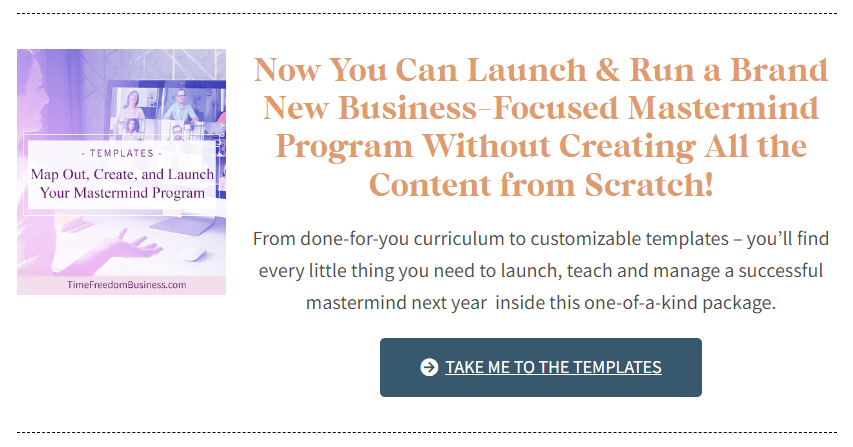Looking for a way to scale back your one-on-one work with clients while also scaling up your business?
You’re in just the spot, friend.
High-level paid masterminds are the lucrative “big sister” of the group coaching program, and they can be a fantastic way to work with more people without stretching yourself too thin on time (or resources).
A paid mastermind is different than a free mastermind, though, where you might round up a few of your #bizbesties to chat over matcha lattes about what happened during your week or what you’re working on the following week.
A paid mastermind is a small group of like-minded individuals who meet regularly to provide support and accountability as they work toward a common goal. A paid mastermind–unlike a more informal mastermind–also has a leader who guides discussion, keeps everyone on track and sometimes even provides bonus content, education or a luxe retreat in Puerta Vallarta.
Paid mastermind members are usually paying for a more high-touch, personalized experience with the leader (more so than they’d get in say, an online course) as well as gaining access to the leaders’ community (aka the other people in the mastermind). As the leader and facilitator, you get to connect others with people who can help them advance their goals and it also offers you the ability to work with multiple people at a time. For example, rather than hosting 11, 1-1 sessions a week, you can work with all 11 clients inside your mastermind on one weekly call. Boom!
Sounds pretty delicious, right? But how do you know if a high-level paid mastermind is the right fit for your business to scale? No worries. Below, you’ll find 5 quick tips for successfully scaling your biz with a high-level paid mastermind group program:
1) Make Sure You Have High-Level Expertise
Here’s the deal: In order to attract people willing to pay a higher price tag for access to you and your community, you need have something worth paying for. Since you’re here, I’m going to assume you do–but it’s still a smart move to take a moment to reflect on and identify the unique knowledge, skills, or experiences that you–and your people, since community is such a huge part of a mastermind–can bring to the table.
2) Know Your Ideal Client–and Whether They Want a Mastermind Group
Of course, you already know the overall ideal client for your business. But do you know the ideal client for your potential mastermind? If not, it’s time to step back & define them. Consider the characteristics of your ideal participants. Are they already achieving a certain level of success? Do they have specific goals, challenges, or aspirations that align with what can help them with?
Also, be sure to think about the clients you already attract–and whether they could benefit from both working with you and/or collaborating with or getting to know each other. (Remember, the community element of a high-level mastermind is a massive selling point.)
Besides knowing who your target audience is for your high-level mastermind group, you also need to assess whether your peeps are actually interested in a high-level mastermind.
Some target audiences love the idea of working with you and connecting with your community. Other audiences truly prefer a one-on-one experience or even doing things themselves with courses or recorded workshops.
Think about how your current clients get results and whether a long-term commitment–coupled with a community element, plus access to guest experts–could help them achieve their goals faster or easier. Is there a need or desire for deeper levels of support, mentorship, and collaboration within your niche/audience – or not so much?
3) Outline Your Offer & Consider Your Bandwidth
You’re already a busy business bombshell – I know that much just because you’re here. While high-level mastermind groups can be major money-makers, they’re definitely not passive income and will require time, energy and resources to create, market and deliver.
Before promoting your shiny new mastermind, take a step back. Do you have the time, energy and mental/emotional/physical resources to do this?
To figure this out, you’ll need to brainstorm what you plan to offer and then what types of resources each part entails. For example, if you plan to offer a core curriculum, do you already have one–or would you need to create it (and use your precious time/energy/resources to do so)?
And don’t forget to consider any extra perks or bonus content you’ll need to round up (or create) as well. Even sourcing and onboarding guest experts will take time & energy. And let’s not forget that helming a retreat in a foreign country isn’t always cheap–or logistically realistic.
Knowing that you’re offering is one piece of the puzzle here. And the other piece? Knowing how many people you can realistically offer it to. How many people can you serve in your mastermind without sacrificing the quality of your interactions? Do you have the emotional and/or physical bandwidth to dedicate sufficient time and attention to each member of the mastermind given what you’ve laid out?
Keep in mind that while some mastermind members will inevitably be more independent, others might take you up on every opportunity to connect. Can you realistically handle “unlimited Voxer access”–or do you need to reconsider in order for everyone to see results (and for you not to feel burnt out in the process)?
Remember, the goal here is to scale your business – aka work with less people and make more money–so if what you’re planning to offer isn’t going to help you do that, don’t be afraid to head back to the drawing board.
4) Crunch the Numbers
Next, you need to make sure it makes financial sense to start a paid mastermind. Add up the total costs involved in running the “core” mastermind (like technology, team members, etc.), as well as any additional expenses like guest speakers or exclusive events.
Once you have a number in mind, you should be able to easily see what you’d need to charge in order to make a profit.
And while most high-level masterminds have luxe price tags to match, keep in mind you still want your clients to feel they’re receiving value that matches said price tag.
5) Do a Gut/Heart Check
Last, but definitely not least: Do you want to run a high-level mastermind? Are you genuinely excited about facilitating a community of like-minded individuals and guiding them towards growth and success in your area of expertise? It’s important to have a genuine interest in supporting others and a willingness to invest time and effort into their progress.
Some people aren’t natural facilitators–and that’s okay! But in order to confidently, competently ‘hold space’ for others, you should have a genuine desire to do it.
Looking at all the above factors, you can now make an informed decision about whether a paid high-level mastermind is the right ‘next thing’ to create for your business. So, are we headed to Puerta Vallarta or what?








